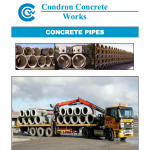Product Data Sheet
CONCRETE PIPES, MANHOLE COMPONENTS AND ANCILLARY PRECAST PRODUCTS MANUFACTURED BY CONDRON CONCRETE WORKS
Composition
The products are composed of cementitious materials and aggregates and possibly admixtures. Certain products may be reinforced with steel.
Hazards
The finished products as supplied are of an inert nature and inherently non-hazardous to health. The individual items are generally heavy and many are so shaped that they can roll easily. Correct handling and stacking procedures as given below must be employed.
Handling/Use Precautions
The weight and surface nature of the products requires the use of protective gloves and footwear to avoid injuries.
- The manual handling of such loads may cause injury should be avoided. Good slinging and lifting practices should always be used and the following points observed:
- Products must not be rolled off vehicles or around sites.
- Chamber rings, Bases and Catch Pits must not be lifted by slinging through the step/rung irons and pipe junctions must not be lifted by slinging around the branch.
- Use correct craneage for offloading vehicles. Properly constructed ‘C’ hooks with spreader bar or canvas/fabric slings with a central lift are recommended.
- Where lifting points are provided, all the lifting points must be used.
- Where lifting points are not provided, then suitable slings (canvas/fabric) should be used around the product and never through it. Correct craneage must always be utilised.
- Chamber rings must not be lifted by slinging through the step/rung irons and pipe junctions must not be lifted by slinging around the branch.
- Care should be taken when breaking down product stacks either on the delivery vehicle or on site.
- Pipe jointing tackle is only to be used for the purpose for which it is supplied.
- When cutting or surface treating products by hand or machine, dust and flying fragments may be created. The dust created may be of respirable size and may contain quartz. Extended periods of exposure to high concentrations of such dust, particularly in enclosed spaces, can constitute a health hazard. In such circumstances, respiratory protective equipment should be worn. Suitable eye protection should be worn to protect against dust and/or flying fragments.
- Provide Trench Supports where necessary.
- Ensure compliance which the Health Safety and Welfare at Work Act 1974.
| Ogee Pipe Loading per 12 Metre Vehicle | Ogee Pipe Loading per 12 Metre Vehicle |
| Pipe | Approx. Number of Ogee pipes per 12 Metre Vehicle |
| 150mm | 450 |
| 225mm | 330 |
| 300mm | 220 |
| 375mm | 160 |
| 450mm | 120 |
| 600mm | 86 |
| 750mm | 40 |
| 900mm | 35 |
| 1050mm | 18 |
| 1200mm | 16 |
| S & S Pipe Loading per 12 Metre Vehicle | S & S Pipe Loading per 12 Metre Vehicle |
| Pipe | Approx. Number of S & S pipes per 12 Metre Vehicle |
| 150mm | 400 |
| 225mm | 200 |
| 300mm | 60 |
| 375mm | 45 |
| 450mm | 30 |
| 525mm | 24 |
| 600mm | 18 |
| 675mm | 16 |
| 750mm | 12 |
| 900mm | 10 |
| 1050mm | 8 |
| 1200mm | 7 |
| 1350mm | 5 |
| 1500mm | 4 |
| 1650mm | 4 |
| 1800mm | 3 |
| 2100mm | 3 |
| 2400mm | 3 |

